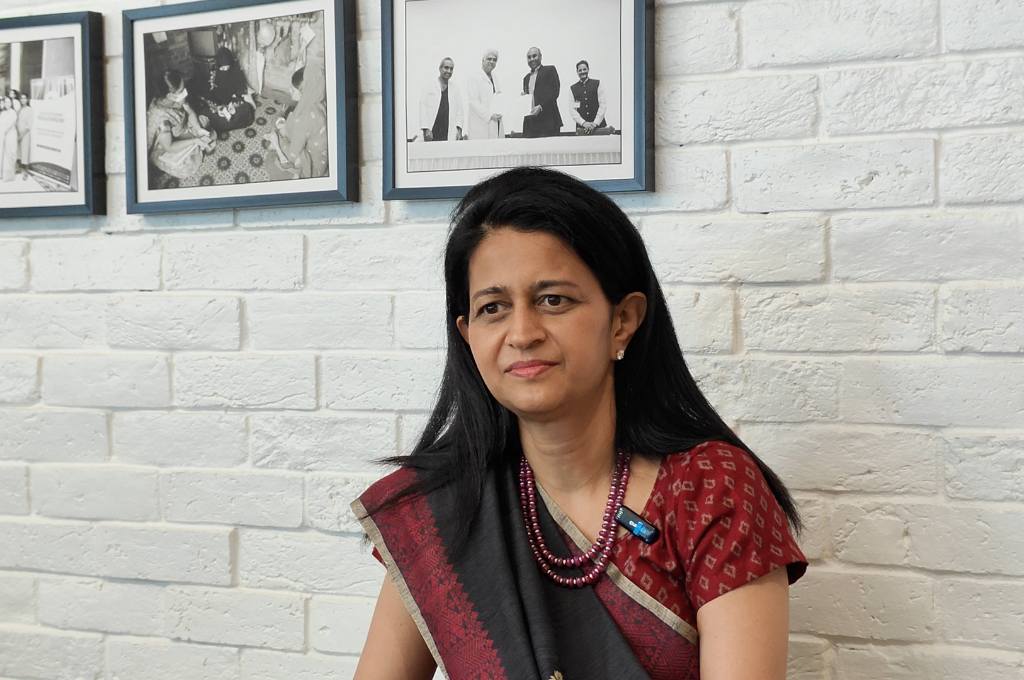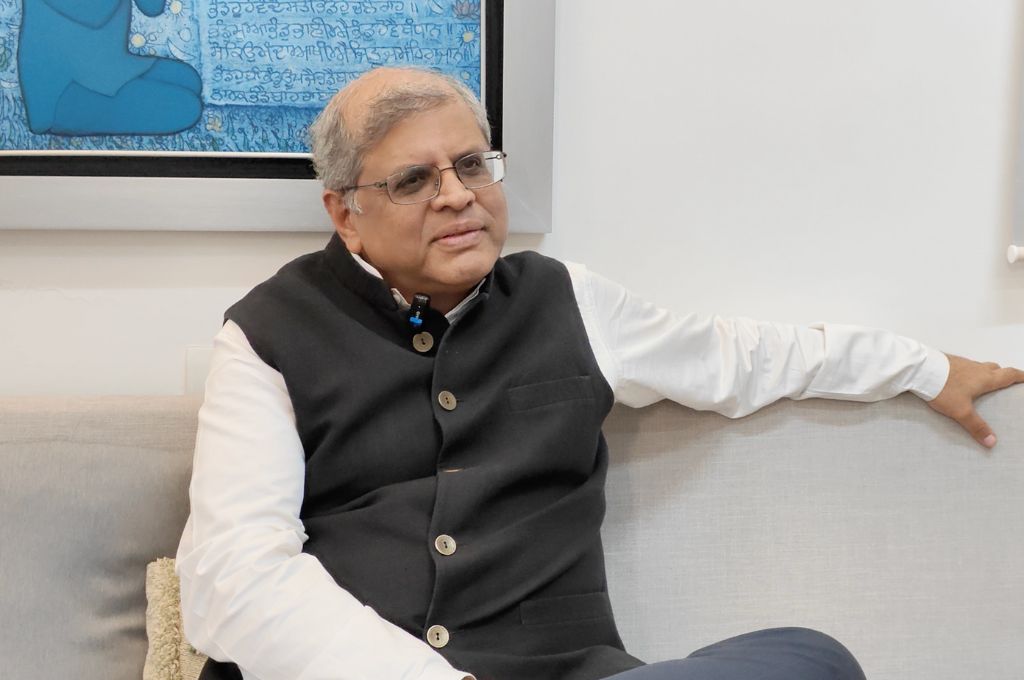The creative manufacturing and handmade (CMH) sector the world over has been on the upswing. Valued at USD 700 billion in 2022, it is expected to vault to USD 1 trillion by 2024. A new combination of market forces drives its upward arc, guided by conscious consumerism—a predilection for products and processes that are environmentally sustainable, socially inclusive, equitable, regional, and invariably artisanal. These imperatives meet Sustainable Development Goal (SDG) 12: responsible consumption and production.
India’s own handmade sector has been growing at a parallel pace. Its exports in FY 2021–22 totalled USD 4.35 billion, a 25.7 percent step up from the year before. In addition to forex, a substantial part of the sector’s revenue is generated domestically. In FY 2020–21, the Indian government pegged the handicraft and handloom sector at INR 25,706.3 crore (approximately USD 3 billion)—a conservative figure because of the nature of the business itself, which lies both within the bounds of the formal economy and outside it, conducted through online retail and organised craft fairs as well as tourist market stalls and doorstep sales. Of late, demand has received further fillip from retail conglomerates that have scaled up their social and artisanal business partnerships.
Second only to agriculture in the size of its workforce—numbering approximately 200 million artisans—the CMH sector, if streamlined, formalised, and levered by relevant technologies, can reap enormous dividends. It can do this through its contribution to the national GDP, and by fostering additional livelihoods, developing India’s entrepreneurial ecosystem, and meeting several SDGs along the way, including climate action through greener supply chains and gender equality by employing and empowering more women. The sector’s potential has never been greater, but whether it inches towards new opportunities or takes a quantum leap towards them depends on a key factor: finance.
Why money matters
Most enterprises in the handmade sector are micro, small, and medium enterprises (MSMEs), located largely in rural India and rooted in a range of cultural traditions. These handmade and craft-based MSMEs (HCMs) serve multiple arms of the cultural economy, from fashion to home decor and tourism, and include artisans and creative producers who shoulder the entire farm-to-consumer value chain.
Let alone scale up, tenuous finances can scupper the handmade sector altogether.
For all its growth and potential, HCMs are hard-pressed for finance and investment that can help them modernise and amplify their operations. According to one study, the credit gap for MSMEs is a staggering USD 397 billion. Finance paves the way for marketing and retail via digital platforms, garners new clients, strengthens and diversifies supply chains, and catalyses innovation in raw material, product, and organisation design, which in turn builds business, livelihoods, and community. Let alone scale up, tenuous finances can scupper the sector altogether.
A stark reminder of this was brought home by the COVID-19 pandemic when an estimated 22 percent of artisans lost 75 percent of their annual income. According to a dipstick survey, 40 percent of artisans were compelled to halt production for the length of the pandemic, citing lack of working capital to keep operations going, while sales for 70 percent of them fell by more than 75 percent.
Terms of estrangement
However, the pandemic was also a tipping point. It accelerated the transition to online sales and expanded, almost overnight, domestic and international markets, creating a new business-to-consumer model for the sector that ejected the intermediary. Newly alert to the sea of possibilities in sales and collaborative partnerships, HCMs are now eager to take the plunge. Financing a Handmade Revolution: How Catalytic Capital Can Jumpstart a Handmade Economy, a report by 200 Million Artisans (200M), finds that 95 percent of HCMs surveyed have sophisticated, digitalised modes of receiving payments, and 89 percent are focused on building brand, growth, and profitability. And yet, only one in 10 have easy access to finance that can help them achieve this.
Here are some of the factors that stymie the sector’s growth.
1. Access to capital
Depending on where they are in their business journey, the financing needs of HCMs differ, but more than two-thirds need some form of financing. 200M’s report finds that approximately 85 percent HCMs need high-risk growth capital to scale; 78 percent need working capital to pay for designers, artisans, raw material, logistics, and so on; 80 percent need finance to innovate and experiment; and 72 percent need it for impact measurement and communication. HCMs typically fall back on their own savings, borrow from informal networks, or funnel their profits back into the operation to scale up.
Most HCMs fall into the ‘missing middle’—they are too big for microfinance and too small for bank loans and impact and commercial investors.
This is why 88 percent of HCMs self-finance their operations and 65 percent prefer to rely on advances against orders. Less than 5 percent of the financing needs of the CMH sector are met by mainstream financing channels, including CSR offices, private investors, microfinance institutions, and handicraft councils. Forty-five percent avoid banks.

2. Women’s access to capital
The problems are compounded for women, who own more than 20 percent of the MSMEs in the country and constitute a significant part of the artisan workforce. Owning few or no collaterals to pledge, with limited mobility and financial literacy compared to men, women find it harder to avail of finance. Fifty-five percent of women-led HCMs surveyed by 200M are unaware of the financing options available to them, compared to 33 percent men-led HCMs, while 62 percent find it difficult to talk to investors, compared to 48 percent men-led HCMs. These are some of the reasons that 56 percent of women-led HCMs rely on self-financing alone, compared to 36 percent men-led HCMs.
3. Investor engagement
Wary of the paperwork, collaterals, and incompatible lending terms (like credit worthiness) stipulated by banks, non-banking financial companies (NBFCs), and mainstream financing channels most HCMs rely on their own resources, even though there are alternative financing instruments they can now turn to, such as convertible notes, purchase order financing, blended finance, and social impact bonds. Not only is their knowledge of new financing opportunities scant, but HCMs are also held back by their diffidence, finding it hard to engage with investors, speak their language, and provide them with growth structures and (hard-to-measure) data on impact they seek. Seventy-four percent of HCMs consider finding, accessing, and engaging with investors a huge problem.
4. Deficient start-up and policy ecosystem
The sector needs to plug into a collaborative network of incubators, accelerators, and think tanks that can grasp its distinct challenges and offer customised solutions, such as providing relevant market intelligence, affordable due diligence and compliance, and public good resource repositories and tools for monitoring and evaluation. Eighty-eight percent of HCMs surveyed by 200M rely on founders, friends, and family for resources and advice.
The road to government policies and schemes is riddled with obstacles.
If the path to a collaborative ecosystem is absent, the road to government policies and schemes is riddled with obstacles. These include the maze of departments this broad and heterogenous sector has to navigate; the complex rules around GST structures, tax breaks, and incentives it has to become acquainted with; and the scattered and impenetrable information about them it has to understand. The report finds that 41 percent of HCMs struggle with GST payments, while 45 percent find it challenging to get industry certification to scale up.
Catalytic capital: A solution
Financing and support to the CMH sector is limited to incubators, accelerators, and a few investors. What HCMs need is a new, purpose-built financing and funding paradigm that is aligned to their modes of production and diverse work cultures. Catalytic capital, a form of investment that is patient, concessionary, adaptable, and open to risk, has just what it takes to transform the CMH sector.
Catalytic capital from actors who haven’t traditionally invested in the sector—impact investors, family philanthropies, CSR, and retail givers—could play a critical role in offering customised investment solutions to the CMH sector. The report highlights that catalytic capital has the potential to:
- De-risk innovation pipelines and support new ideas across diverse value chains.
- Raise the credibility, investment readiness, and impact potential of MSMEs, allowing them to scale and attract additional financing.
- Enable formal inclusion of first-mile artisan communities and encourage mainstream start-up actors to actively participate in the CMH ecosystem.
- Catalyse SDG impact and policy action by building an enabling environment to drive impact goals.
- Build accountability and incentives for impact generation by offering “better terms for better impact” to market-based HCMs.
Revolution road map
The time is ripe for a revolution in the CMH sector, but tilting the scales will require all actors to work in tandem. Here are some recommendations from the report:
Investors and funders can set up sector-specific, creativity-led portfolios that prioritise responsible consumption and production. They need to partner with philanthropic and policy actors to introduce catalytic capital offerings that de-risk financing for the CMH sector.
Policymakers should create an enabling environment for HCMs and investors by supporting data mapping specific to the sector; creating a single-window policy for schemes, grants, and information; and minimising the compliance burden by simplifying legal structures.
Ecosystem actors can create public-good infrastructure that enables the different players in the sector to communicate and collaborate. They can leverage technology to deliver data, market intelligence, and market access networks to stakeholders, and guide policy-makers and investors to direct the right capital across specific needs in the farm-to-consumer value chain.
Enterprises should seek access to tools, resources and collaborative networks and build a clear and differentiated value proposition centred around an understanding of the conscious customer as well as gaps in the value chain.
Innovations in technology, emerging business models, an evolving entrepreneurial environment, and an expanding marketplace have placed India’s creative manufacturing and handmade sector on the ledge of change. One study estimates that the country has a USD 140 billion low-skills manufacturing gap in clothing and textiles alone, a gap the CMH sector can easily plug under the right conditions. But those conditions can only be produced when capital, technology, and policy join hands. That’s when we’ll have a handmade revolution that will truly deliver the goods.
—
Know more
- Read about how investing in women artisans can catalyse India’s economy.
- Explore case stories of enterprises in the creative and handmade sector.
- Read this story about the last hand-block printer in Gujarat.





